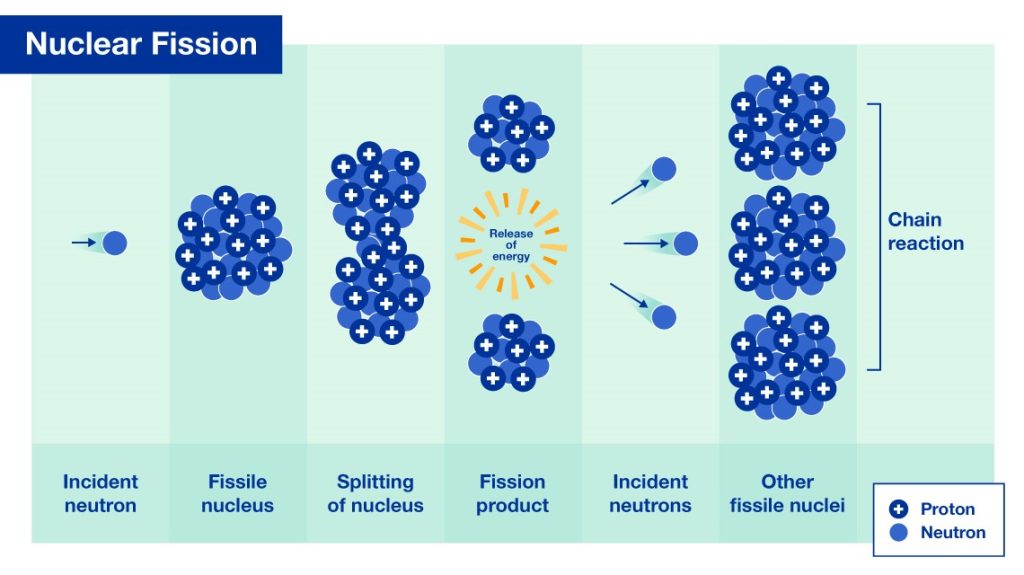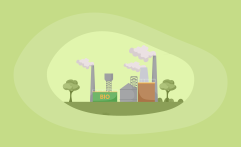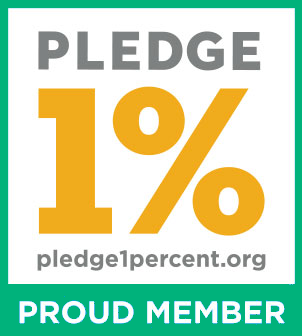Nuclear Fission: All 6 Pros and 3 Cons Explained
Affiliate Disclosure
Hey fellow impactful ninja ?
You may have noticed that Impactful Ninja is all about providing helpful information to make a positive impact on the world and society. And that we love to link back to where we found all the information for each of our posts.
Most of these links are informational-based for you to check out their primary sources with one click.
But some of these links are so-called "affiliate links" to products that we recommend.
Why do we add these product links?
First and foremost, because we believe that they add value to you. For example, when we wrote a post about the environmental impact of long showers, we came across an EPA recommendation to use WaterSense showerheads. So we linked to where you can find them. Or, for many of our posts, we also link to our favorite books on that topic so that you can get a much more holistic overview than one single blog post could provide.
And when there is an affiliate program for these products, we sign up for it. For example, as Amazon Associates, we earn from qualifying purchases.
What do these affiliate links mean for you?
First, and most importantly, we still only recommend products that we believe add value for you.
When you buy something through one of our affiliate links, we may earn a small commission - but at no additional costs to you.
And when you buy something through a link that is not an affiliate link, we won’t receive any commission but we’ll still be happy to have helped you.
What do these affiliate links mean for us?
When we find products that we believe add value to you and the seller has an affiliate program, we sign up for it.
When you buy something through one of our affiliate links, we may earn a small commission (at no extra costs to you).
And at this point in time, all money is reinvested in sharing the most helpful content with you. This includes all operating costs for running this site and the content creation itself.
What does this mean for me personally?
You may have noticed by the way Impactful Ninja is operated that money is not the driving factor behind it. It is a passion project of mine and I love to share helpful information with you to make a positive impact on the world and society. However, it's a project in that I invest a lot of time and also quite some money.
Eventually, my dream is to one day turn this passion project into my full-time job and provide even more helpful information. But that's still a long time to go.
Stay impactful,
Nuclear fission accounts for roughly 9% of the world’s electricity generation. It can play an important role in the global energy transformation and help transition away from fossil fuels, but it comes with drawbacks as with any other energy source. So, we had to ask: What are the pros and cons of nuclear fission?
The main pros of nuclear fission include energy density, low carbon and land footprints, air quality protection, few waste products, and energy independence. However, the main cons of nuclear fission include it being a nonrenewable resource and negative environmental impacts from nuclear waste.
Keep reading to find out all about what the pros and cons of nuclear fission are, how effective and efficient it is, how it can mitigate climate change, and how safe or dangerous it is.
The Big Picture of Nuclear Fission
Nuclear fission, one of two ways to produce nuclear energy, is the generation of energy produced when splitting apart the nucleus of an atom.
“Nuclear fission: a nuclear reaction in which a heavy nucleus splits spontaneously or on impact with another particle, with the release of energy.”
Cambridge Dictionary

All operating nuclear power plants today utilize the process of nuclear fission. Because of this, nuclear fission is commonly referred to as ‘nuclear energy’ in the data and literature.
| 6 Pros of Nuclear Fission | 3 Cons of Nuclear Fission |
| Nuclear fission has a low carbon footprint | Nuclear fission can negatively impact the environment |
| Nuclear fission protects air quality | Nuclear fission generates nuclear waste |
| Nuclear fission has a small land footprint | Nuclear fission is not a renewable energy source |
| Nuclear fission is energy-dense | |
| Nuclear fission generates few waste products | |
| Nuclear fission promotes energy independence and energy security |
What Are 6 Pros of Nuclear Fission
Nuclear fission has a low carbon footprint, protects air quality, has a small land footprint, is energy dense, generates few waste products, and promotes energy independence.
Pro #1: Nuclear Fission Has a Low Carbon Footprint
Nuclear fission has one of the lowest carbon footprints out of all energy types.
Nuclear Fission Pro #1
The carbon footprint is one of the ways we measure the effects of human-induced global climate change. It primarily focuses on the greenhouse gas (GHG) emissions associated with consumption and includes other emissions such as methane (CH4), nitrous oxide, and chlorofluorocarbons (CFCs).
“Carbon footprint: the amount of greenhouse gasses and specifically carbon dioxide emitted by something (such as a person’s activities or a product’s manufacture and transport) during a given period”
Merriam Webster
On a life-cycle basis, nuclear fission emits 12 grams of CO2 equivalent per kWh of electricity produced, the second lowest out of all fuel types.
Have a look at the illustration below to see the average life-cycle CO2 equivalent emissions of different energy sources and how they compare to nuclear fission.

Overall, nuclear fission has one of the lowest carbon footprints out of all energy types, making it one of our cleanest sources of energy.
Pro #2: Nuclear Fission Protects Air Quality
Nuclear fission produces a fraction of the pollution and toxic chemicals that fossil fuels produce, helping to protect air quality.
Nuclear Fission Pro #2
Air pollution can cause numerous health problems including asthma, breathing difficulties, brain damage, heart problems, and cancer. Fossil fuel (coal and natural gas) combustion emits coal ash residue, toxic heavy metals, CO2, carbon monoxide (CO), sulfur dioxide (SO2), and nitrogen oxides (NOx) into the atmosphere, impairing public health.
A 1-inch, Uranium-235 pellet contains the energy equivalent of 1 ton of coal. And since 1 ton of coal creates 2.086 tons (4,172 lbs) of CO2 when it is burned, every 1-inch pellet of nuclear fuel directly avoids the emission of over 2 tons of CO2 from our atmosphere.
In short, nuclear fission is a clean burning source of energy that produces minimal greenhouse gasses and emits no CO, SO2, or NOx, thereby helping to protect air quality.
Pro #3: Nuclear Fission Has a Small Land Footprint
Nuclear fission produces more power on less land than any other energy source.
Nuclear Fission Pro #3
Nuclear power produces more electricity on less land than any other clean-air source. A standard, 1,000-megawatt facility requires only a little more than 1 square mile to operate, a number that is 360 and 75 times less than what is required for wind farms and solar power plants, respectively.
Overall, nuclear fission uses only 0.3 square meters of land per megawatt-hour of electricity produced, the lowest out of all energy types.

To put it into perspective, it would take more than 3 million solar panels, or 430 wind turbines, to produce the same amount of power as a typical nuclear fission commercial reactor.
Pro #4: Nuclear Fission Is Energy Dense
Nuclear fuel is extremely energy-dense, so you don’t need a lot of it to create a lot of energy.
Nuclear Fission Pro #4
Nuclear fuel is extremely energy-dense, so you don’t need a lot of it to create a lot of energy. It would only take ten U-235 pellets to power the average household for a year.
A single, 1-inch tall Uranium-235 pellet contains the energy equivalent of:
- 1 ton of coal
- 120 gallons of oil
- 17,000 cubic feet of natural gas
Because it is so energy-dense, nuclear fission is also incredibly energy-efficient. And energy efficiency is beneficial because it conserves resources, saves money, and increases the reliability of our energy grid as a whole.
Pro #5: Nuclear Fission Generates Few Waste Products
Nuclear fission produces substantially less waste than other forms of energy.
Nuclear Fission Pro #5
Just as with any energy source, nuclear fission generates some waste products. But the amount generated is substantially less than other forms of energy.
A nuclear fission reactor supplying a person’s energy needs for an entire year produces only a brick-sized amount of nuclear waste. And only 5 grams of that, equivalent to the weight of a sheet of paper, is considered to be a high-level, radioactive waste.
In comparison, the average coal-fired power plant produces roughly 300,000 tons of coal ash and more than 6 million tons of CO2 every year. In the US alone, you could fit all of its used nuclear fuel over the past 60 years into a single football field at a depth of less than 10 yards (30 feet).
Pro #6: Nuclear Fission Promotes Energy Independence and Energy Security
Nuclear fission can help us transition away from fossil fuels and toward an energy-independent future.
Nuclear Fission Pro #6
Being able to produce your own electricity without the aid of foreign countries is an important step in becoming more self-sufficient. For example, in the US, Former President George W. Bush signed the Energy Independence and Security Act of 2007 to reduce US dependence on oil, expand the production of renewable energy, and confront global climate change.
Although nuclear energy alone cannot shoulder the burden of the world’s electricity needs, it can shoulder a substantial amount. Nuclear energy accounted for roughly 9% of global electricity generation in 2023, generating 2,685 TWh of electricity from 440 power reactors with over 400 GW of installed capacity.
What Are 3 Cons of Nuclear Fission
Nuclear fission is a nonrenewable energy source that can negatively impact the environment and generates nuclear waste.
Con #1: Nuclear Fission Can Negatively Impact the Environment
Uranium mining can contaminate the environment with radiation, water-borne toxins, and radon gas.
Nuclear Fission Con #1
The main fuel source for nuclear fission is Uranium, a naturally occurring, radioactive element found in the Earth’s crust. Mining Uranium involves digging either open-air pits or access shafts and tunnels.
Uranium mining contaminates the environment with radioactive dust, radon gas, water-borne toxins, and increased levels of background radiation. Exploratory drilling and mining also heavily increase the risk of contaminating aquatic ecosystems. Small amounts of pollutants can poison and bioaccumulate in fish, cause reproductive problems and deformities in aquatic species, and contaminate water and land-based ecosystems for hundreds of years.
Con #2: Nuclear Fission Generates Nuclear Waste
Nuclear fission produces nuclear waste that is radioactive and can remain hazardous for many years.
Nuclear Fission Con #2
Although nuclear power produces minimal waste, the waste that it does produce is radioactive and can remain hazardous for many thousands of years. These radioactive waste products include uranium mill tailings, spent (used) reactor fuel, and other radioactive wastes.
There are three types of nuclear wastes that are classified based on their radioactivity:
- High-level: Used nuclear fuel from the nuclear reactions accounting for 3% of the total volume of nuclear waste and containing 95% of the total radioactivity.
- Intermediate-level: Used filters, steel components, and effluents from reprocessing accounting for 7% of the total volume of nuclear waste and containing 4% of the total radioactivity.
- Low-level: Lightly contaminated items like tools and work clothing account for 90% of the total volume of nuclear waste and contain 1% of the total radioactivity.
High-level nuclear waste poses a threat if not disposed of and isolated from the environment properly because it remains radioactive for many years.
Con #3: Nuclear Fission is a Nonrenewable Energy Source
Nuclear energy is a nonrenewable energy source that will eventually be depleted.
Nuclear Fission Con #3
Nonrenewable energy sources are those that will run out in our lifetime or will not be replenished in many, many lifetimes.
“Nonrenewables: existing in limited quantities that cannot be replaced after they have all been used”
Cambridge Dictionary
Nuclear fission is classified as nonrenewable energy because nuclear fuel (Uranium) is a finite material that can only be found in certain locations in the Earth’s crust.
Nuclear power plants use the second most common isotope of Uranium (U-235) which has a relative abundance of only 0.7%. And most of the original U-235 on earth has already decayed because it has a half-life of about 700 million years.
Although nuclear power plants use only tiny amounts of Uranium in the fission process and can be used as a reliable energy source for decades to come, we will still run out at some point. And once we run out of Uranium-235, we won’t be able to generate the nuclear fission reaction anymore.
How Can Nuclear Fission Help Mitigate Climate Change
Climate change is a severe, long-term consequence of fossil fuel combustion. If left untreated, atmospheric CO2 can remain there for tens of thousands of years and exacerbate the negative effects of climate change. Nuclear fission emits less CO2 upon operation than fossil fuels and can therefore reduce our total emissions.
How Is Climate Change Defined
Climate change is arguably the most severe, long-term global impact of CO2. Every year, we emit approximately 37 billion tons of CO2. The carbon found in fossil fuels reacts with oxygen in the air to produce CO2.
“Climate change: changes in the earth’s weather, including changes in temperature, wind patterns, and rainfall, especially the increase in the temperature of the earth’s atmosphere that is caused by the increase of particular gasses, especially carbon dioxide.”
Oxford Dictionary
When carbon enters the atmosphere, it absorbs sunlight and solar radiation, trapping the heat and acting as an insulator for the planet.
Since the Industrial Revolution, Earth’s temperature has risen a little more than 1 degree Celsius (°C), or 2 degrees Fahrenheit (°F). Between 1880-1980 the global temperature rose by 0.07°C every 10 years. This rate has more than doubled since 1981, with a current global annual temperature rise of 0.2°C, or 0.36°F, for every decade.
How Does Nuclear Fission Specifically Help Mitigate Climate Change
The global average concentration of CO2 in the atmosphere today registers at 419 parts per million (ppm), the highest ever recorded. Nuclear fission can help lower this concentration because it can replace some of the burning of fossil fuels (e.g., coal, oil, natural gas) with a cleaner form of renewable energy.
Nuclear energy helps to avoid 1.5 gigatons of greenhouse gas (GHG) emissions per year and 180 billion cubic meters of global gas demand per year. In the past 50 years, nuclear energy has helped avoid over 70 gigatons of GHG emissions.
Increasing nuclear fission energy usage can reduce CO2 emissions, and the more we reduce CO2 emissions, the more we combat the negative effects associated with climate change including temperature rise, sea-level rise, ice melting, and ocean acidification. When these rates are slowed, the earth’s biodiversity does not have to struggle to adapt to temperature and pH changes. People will not be displaced due to the flooding of coastal areas. And icebergs will continue to provide climate regulation.
How Effective and Efficient Is Nuclear Fission
In terms of effectiveness, nuclear fission effectively generates nuclear energy that has a low carbon footprint, protects air quality, and promotes energy independence. However, it is also a nonrenewable energy source.
In terms of efficiency, nuclear fission efficiently generates nuclear energy, has a small land-use footprint, and generates few waste products.
Nuclear fission is effective because:
- Nuclear fission has become one of our largest global contributors of carbon-free electricity, accounting for roughly 10% of the world’s energy generation.
- Nuclear fission has the second-lowest carbon footprint out of all fuel types. On a life-cycle basis, nuclear fission emits 12 grams of CO2 equivalent per kWh of electricity produced.
- Nuclear fission produces a fraction of the pollution and toxic chemicals that fossil fuels produce, helping to protect air quality.
- Nuclear can help us transition away from fossil fuels and towards an energy-independent future.
However, a main drawback associated with nuclear fission is that it is classified as a nonrenewable resource. Once we run out of Uranium-235, we won’t be able to generate the nuclear fission reaction anymore.
Nuclear fission is efficient because:
- Nuclear fuel is extremely energy-dense, so you don’t need a lot of it to create a lot of energy.
- Nuclear fission has a small land-use footprint, using only 0.3 square meters of land per megawatt-hour of electricity produced, the lowest out of all energy types.
- A nuclear fission reactor supplying a person’s energy needs for an entire year produces only a brick-sized amount of nuclear waste.
How Safe or Dangerous Is Nuclear Fission
Overall, nuclear fission is considered to be minimally dangerous. Holistically and throughout its life cycle, fission is safe and beneficial for human and animal health, the environment, and the energy grid. It is also significantly safer than fossil fuels and some other types of renewable energy.
Here’s How Safe Nuclear Fission Is
Overall, nuclear fission is a safe form of energy regarding human and animal health, the environment, the energy grid, and throughout all stages of its life cycle.
| How Safe Is Nuclear Fission at a Holistic Level | Human and Animal Health: Nuclear fission is considered safe when it comes to human and animal health due to the rarity of nuclear accidents in fission’s overall history. Environment: Nuclear fission emits minimal greenhouse gas emissions and has a minimal effect on the environment, provided that proper siting of nuclear facilities and disposal of nuclear waste occurs. Energy Grid and Infrastructure: Nuclear fission is not only safe, but it is also a beneficial addition to our energy grid and supporting infrastructure. |
| How Safe Is Nuclear Fission Across Its Life-Cycle | Building: Safe work practices and proper training can mitigate the risks associated with the building stage of nuclear fission. Operating and Maintaining: Nuclear fission is generally considered safe to operate and maintain, if proper precautionary measures are followed. Building Back: This final stage is considered to be safe overall, with the hazard of handling, containing, and disposing of spent nuclear fuel able to be mitigated with proper procedures and safe work practices. |
| How Safe Is Nuclear Fission In Comparison to Other Types of Energy | Nuclear fission is one of our safest forms of energy that has one of the lowest death rates from accidents and air pollution per unit of electricity generation. |
Here’s How Dangerous Nuclear Fission Is
Overall, nuclear fission is considered minimally dangerous in terms of human and animal health, the environment, the energy grid, and through all stages of its life cycle.
| How Dangerous Is Nuclear Fission Overall | Overall, nuclear fission is considered minimally dangerous in terms of human and animal health, the environment, the energy grid, and through all stages of its life cycle. |
| How Dangerous Is Nuclear Fission at a Holistic Level | Human and Animal Health: Nuclear fission can be dangerous to human and animal health if proper measures are not in place. Environment: Nuclear fission is minimally dangerous to the environment, provided that proper siting of nuclear facilities and disposal of nuclear waste occurs. Energy Grid and Infrastructure: Nuclear fission is not considered to be dangerous to our energy grid and supporting infrastructure. |
| How Dangerous Is Nuclear Fission Across Its Life-Cycle | Building: Nuclear power plant construction and uranium mining come with risks involving radiation exposure. Operating and Maintaining: Uncontrolled release of radioactive material is the main concern associated with operating nuclear fission. Building Back: Decommissioning nuclear facilities comes with risks involving direct contact with spent nuclear fuel. |
| How Dangerous Is Nuclear Fission in Comparison to Other Types of Energy | Nuclear fission is one of our safest forms of energy that has one of the lowest death rates from accidents and air pollution per unit of electricity generation. |
Final Thoughts
Nuclear fission has a low carbon and land footprint, protects air quality, is energy dense, generates few waste products, and promotes energy independence and security. However, nuclear fission is also a nonrenewable energy source that generates nuclear waste, which can negatively impact the environment.
Despite this, the pros of nuclear fission outweigh the cons. Beginning to reverse the climate crisis means we have to cut CO2 emissions now, and nuclear fission can help us do that. Nuclear fission has the second-lowest carbon footprint out of all energy types and emits a fraction of the CO2 and air toxics that fossil fuels emit.
Although its future remains uncertain due to negative public opinion, incorporating more nuclear fission-generated energy into our power grid has many benefits.
Stay impactful,

Sources
- International Atomic Energy Agency: What is Nuclear Energy? The Science of Nuclear Power
- International Atomic Energy Agency: What is Nuclear Energy? The Science of Nuclear Power
- Impactful Ninja: Nuclear Power Explained: All You Need to Know
- Nuclear Fission: International Atomic Energy Agency
- Impactful Ninja: How Does Nuclear Fission Work? From Source Til Energy Generation
- Britannica: Carbon footprint | Definition, Examples, Calculation, Effects, & Facts
- World Nuclear Association: Carbon Dioxide Emissions From Electricity
- World Nuclear Association: Average life-cycle CO2 equivalent emissions
- Impactful Ninja: What Is the Carbon Footprint of Nuclear Fission? A Life-Cycle Assessment
- Union of Concerned Scientists: Coal Power Impacts
- Freeing Energy: How much CO2 and pollution comes from burning coal?
- US Energy Information Administration: Nuclear power and the environment
- US Department of Energy: 3 Reasons Why Nuclear is Clean and Sustainable
- Our World in Data: How does the land use of different electricity sources compare?
- Visual Capitalist: The Power of a Uranium Pellet Compared to Fossil Fuels
- Nuclear Energy Institute: Nuclear Fuel
- US Department of Energy: Energy Efficiency: Buildings and Industry
- World Nuclear Association: What is nuclear waste and what do we do with it?
- US Environmental Protection Agency: Summary of the Energy Independence and Security Act
- Our World in Data: Nuclear Power Generation
- Impactful Ninja: The History of Nuclear Fission
- International Atomic Energy Agency: What is Uranium?
- National Institutes of Health: Uranium mining and health
- Biological Diversity: Uranium
- World Nuclear Association: Radioactive Wastes – Myths and Realities
- National Geographic: Nonrenewable Energy
- National Grid Group: Why is nuclear a clean energy?
- World Nuclear Association: Uranium Mining Overview
- Natural Resources Defense Council: Global Warming 101
- United Nations Framework Convention on Climate Change: The Paris Agreement
- National Oceanic and Atmospheric Administration: Climate Change – Atmospheric Carbon Dioxide
- Impactful Ninja: Fossil Fuel Energy Explained: All You Need to Know
- Impactful Ninja: Coal Energy Explained: All You Need to Know
- Impactful Ninja: Oil Energy Explained: All You Need to Know
- Impactful Ninja: Natural Gas Energy Explained: All You Need to Know
- International Energy Agency: Executive summary – Nuclear Power and Secure Energy Transitions
- How Effective and Efficient Is Nuclear Fission? A Holistic Life-Cycle Analysis
- How Safe Is Nuclear Fission? A Holistic Life-Cycle Analysis
- How Dangerous Is Nuclear Fission? A Holistic Life-Cycle Analysis
- US Energy Information Administration: Nuclear power and the environment
- World Nuclear Association: Occupational Safety in Uranium Mining
- Nuclear Energy Institute: Here’s How a Nuclear Reactor Actually Works
- Natural Resources Defense Council: Nuclear Power 101
- Our World in Data: What are the safest and cleanest sources of energy?
- Beyond Nuclear International: Nuclear power and harm to animals
- US Energy Information Administration: Delivery to consumers







